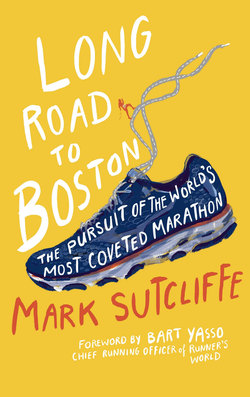Читать книгу Long Road to Boston - Mr Mark Sutcliffe - Страница 3
На сайте Литреса книга снята с продажи.
FOREWORD
ОглавлениеBy Bart Yasso
The course of the Boston Marathon hasn’t changed very much over the past one hundred and twenty years. Hundreds of thousands of runners have left Hopkinton and have moved in almost a straight line, with only a handful of turns, to Boylston Street in Copley Square. When the gun goes off, we all travel the same path to the finish line.
But each one of those runners takes a different route to get to the start line. What prompts all of us first to do a marathon, then to strive for and achieve a qualifying time, then actually to run the Boston Marathon? I’ve talked to thousands of Boston runners over the past thirty-five years, and every story is different.
I first ran Boston in 1982, the year of the famous “duel in the sun” between Alberto Salazar and Dick Beardsley. On my first visit, I spent a lot of time before the race walking around the city, and discovered first-hand what so many people had told me about the atmosphere on marathon weekend. As soon as people find out you’re a runner, they want to know where you’re from and every detail about your story. Wherever you go that weekend, people are talking about the marathon.
Since then, I’ve been to Boston every single Patriots’ Day, a few times as a runner but mostly in my capacity as Chief Running Officer of Runner’s World. I’ve seen the race transform from a fairly small event populated by very fast athletes into an enormous spectacle that has become the ultimate goal for the everyday runner.
What makes the Boston Marathon special is its unparalleled history. It’s not the most picturesque marathon course in the world. It’s not run at the best time of year; the weather can be very unpredictable. But what no other event can match is the one-hundred and twenty years of tradition. There are runners who have been back every year for decades. There are families who have shown up to the same location as spectators every year for generations. Because the race is run on a holiday, it’s like a party on the streets.
The race has changed, but the tradition hasn’t. Thirty years ago, a small group of runners gathered every April in tiny Hopkinton. Now it’s a field in the tens of thousands. The first few years I ran Boston, there were spectators edging onto the course; by the time you got to Commonwealth Avenue, it was so narrow in some places that runners were traveling almost in single file. If you wanted to pass someone, you had to tap him or her on the shoulder and ask him or her to move over. Now it’s a highly organized, professionally run event run by an extraordinary team. Once upon a time, when you got to the finish line, you got the time that was on the clock when you crossed. Now there’s a sophisticated chip timing system, one of many technological improvements to racing.
What also hasn’t changed over the decades is the passion of the runners who seek an invitation to run Boston. Every year, I’m amazed by the stories of people who have made the Boston Marathon the most important item on their bucket list, the pinnacle of their running career. Some people train for years just to get in. The qualifying standards are a big part of the appeal: runners know that it’s not a free ticket. You have to earn the right to a bib number in Boston.
Mark’s story is a perfect example. He’s been running marathons for more than a decade and started getting closer to qualifying in his sixteenth marathon. Like so many other runners, he didn’t give up. I admire the commitment, persistence and determination of all the runners who have made Boston a significant goal in their lives. I never get tired of meeting the runners who are doing Boston for the first time and seeing how much it means to them. In my experience, the most amazing stories are in Boston, because runners have gone through so much sacrifice just to get there.
The Boston Marathon continues to be a magical event I look forward to every year. This book captures exactly why it’s the most prestigious and most cherished race on the planet.
“Running is a big question mark that’s there each
and every day. It asks you: Are you going to be a wimp
or are you going to be strong today?”
PETER MAHER
